The Ultimate Guide to “What is SEO and How it Works”
SEO stands for SEO stands for Search Engine Optimization which is the method employed to improve a website’s technical structure, content relevancy and link popularity.
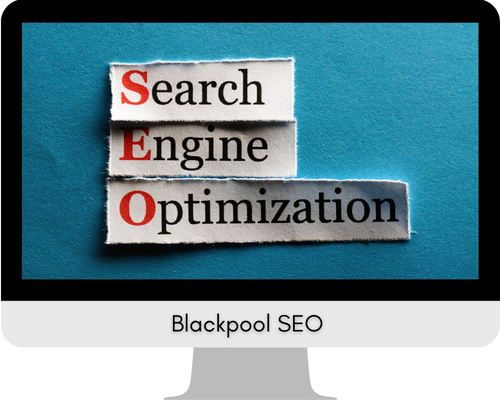
The Ultimate Guide to “What is SEO and How it Works”
Search Engine Optimization (SEO)
SEO stands for SEO stands for Search Engine Optimization which is the method employed to improve a website’s technical structure, content relevancy and link popularity, so that its pages are easily found more relevant and popular for users who search In turn the websites are ranked higher by search engines.
Search engines suggest SEO strategies that improve both the user experience as well as page’s rankings, by providing content that meets the requirements of searchers. This is done by using relevant keywords in meta descriptions, titles as well as headlines (H1) with descriptive URLs using keywords, not numeral strings, as well as schema markup that specifies the meaning of the content on the page, in addition to other SEO best techniques.
Defining Search Engine Optimization (SEO)
Let’s begin by asking an obvious question: what is SEO? It’s simple. SEO refers to ‘Search Engine Optimization (also known as SEO) which is the method to get traffic from organic, free or editorial results of search engines. It is designed to increase the position of your website on the search results pages. Keep in mind that the higher your website’s ranking in search results, the more people will be able to see it.
Good SEO is a mix of actions, including:
- Selecting keywords relevant to your needs that have high potential for traffic to your site
- Producing valuable, high-quality content as well as optimizing the content for SEO, as well as for the users
In addition, we provide relevant links from top-quality websites
Thus, SEO or Search Engine Optimization (SEO) refers to the process of designing your website to be higher in the search engine result page (SERP) to ensure that you get more visitors. The goal is usually to be in the very first position of Google results for keywords which are the most important to the people you want to reach. Thus, SEO is as much as a matter of understanding the wants and demands of your customers and the technical aspect of how to set up your site.
Today, SEO is considered an important part of marketing. Search engines aid people in finding the information they’re seeking online. If you’re researching a particular product, seeking the perfect restaurant, or planning vacations Search engines are the most common place to start whenever you require information. For entrepreneurs, they provide an excellent opportunity to drive users to your site.
The Three SEO Pillars SEO
As a digital marketing professional, understanding how to get your website, brand or company noticed by searchers is an essential skill and knowing the way SEO changes will keep you on most effective. Although SEO evolves frequently in subtle ways, its core concepts don’t. It is possible to break SEO into three main elements or pillars that you should be aware with, and implement frequently:
Technical Optimization Technical Optimization:
Technical Optimization is the process of carrying out activities on your website designed to boost SEO, but they are not directly related to content. It usually happens in the background.
On-Page Optimization:
On-Page Optimization is the process used to ensure that the content you publish on your site is useful and offers an excellent user experience. It involves focusing on the appropriate keywords in your content. It is done using the use of a CMS. Examples of common content management systems are WordPress, Wix, Drupal, Joomla, Magento, Shopify as well as Expression Engine.
Off-Page Optimization
Off-Page Optimization can be described as the method of increasing the rankings of your website’s search engines through actions outside of the website. This is driven mainly by backlinks, which aid to improve the image of the website.
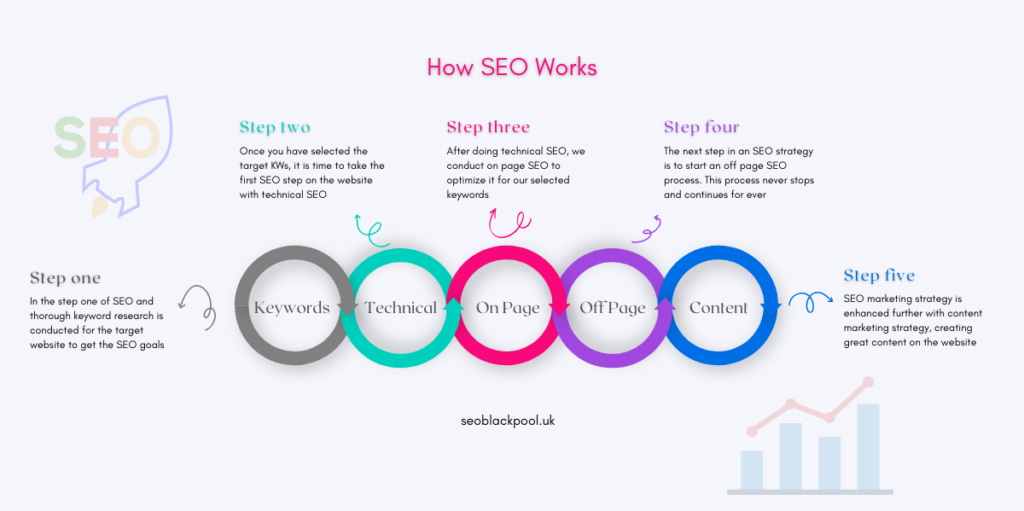
The Differences Between Organic and Paid Search
In the beginning it is essential to be aware of the distinctions between natural, organic search associated by SEO or paid-for search. There are five main differentiators:
Position
The main distinction is that paid search results are displayed on top of search engine result pages while organic results are displayed below them.
Time
The other major distinction between organic and paid search is the amount of time. In the case of paid search, you will get close to instant results, and sometimes within minutes. In contrast organic search results take longer typically months, weeks, or even years. Therefore, you must play the long-term to medium-term game of organic search.
Payment
In the case of paying for search traffic as the name implies that paid search traffic is paid. Pay-per-click (PPC) on the cost per click (CPC) system. That means, you pay a cost each time a user clicks your advertisement. Instead of relying upon organic traffic to your site and buying traffic, you can purchase visitors to your website through paying Google to display your ads when a visitor performs the search for the keyword you have chosen. Organic search it is not expensive, however it requires the investment of time and resources.
ROI
When it comes to ROI, also known as return on investment, or ROI, it’s simpler to quantify with paid search. It’s due in part to the fact that Google offers more data on keywords that can be gathered within Google Analytics. With paid search, however, ROI can stagnate or diminish in time. In the case of natural search results, the ROI can be slightly more difficult to quantify, however it tends to improve over time. In the long run organic search may provide the best returns on investments.
Traffic share
In terms of the proportion of traffic that is used approximately 20%-30 percent of users use paid search results, and 70 to 80 percent of users use results from SEO. The majority of clicks is actually natural results.
Similarities Between Organic and Paid Search
There are many differences between organic and paid search. There are also commonalities between organic and paid search:
Research on keywords
Users utilize the search engine to perform organic and paid searches, and both require users to input a keyword. Therefore, you must conduct keyword research for organic as well as paid search.
The landing pages
Both kinds of search require the creation of landing pages. For SEO your landing page, it needs to be linked to your site. If you are using Paid search, the landing page may be the exact landing page that you use for organic search, or it could be a separate, standalone page that is a part of your site.
Traffic
Creating traffic is a primary objective for both organic and paid search. The most important thing is that both organic and paid search traffic is based on the user’s intent. This means that if when someone is using Google an inquiry or searching for information, they are actively thinking and consequently tend to act when they discover this information.
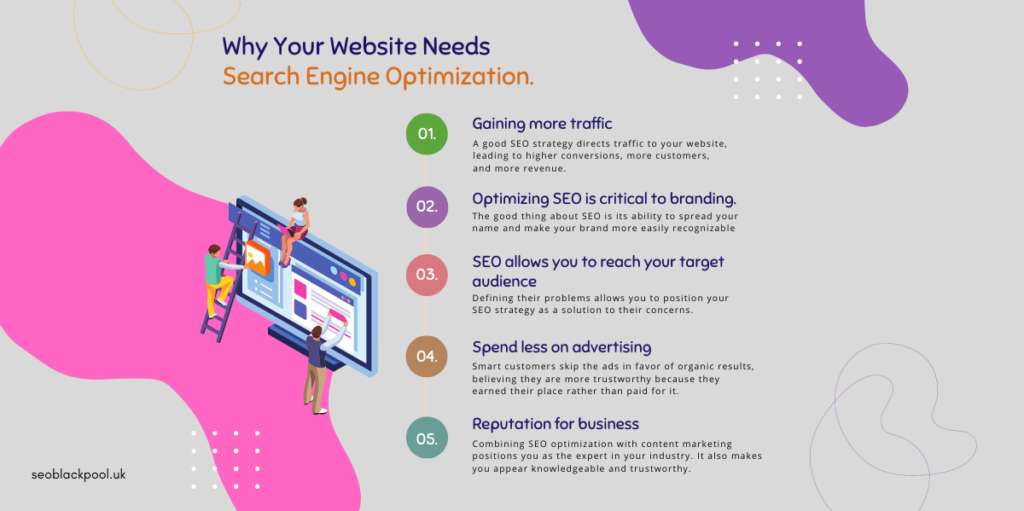
Why Is SEO Essential to Digital Marketing?
SEO is a crucial aspect of digital marketing since users conduct trillions of searches each year, usually with commercial motives to locate information on products and services. Search is typically the main source of traffic to digital for companies and is a complement to other channels for marketing. A higher ranking and visibility in search results than your competitors can have an impact on your profits.
The search results have evolved over the last few years to provide more specific answers and information which is better suited to keeping them on the page for results instead of directing them to different websites.
Additionally, features like Knowledge Panels and rich results in search results can improve visibility and provide users with additional information about your company specifically in results.
In short, SEO is the foundation of a comprehensive marketing system. If you are aware of the needs of your visitors to your site You can implement this knowledge into your marketing campaigns (paid as well as organic) and across your site and on your other social media sites and much more.
The aim for SEO is to increase your rank in organic results for search. There are various methods to optimize AdWords as well as shopping and local results. Although it might appear that all the competing elements taking up space on SERPs make it difficult for SEO to push organic results to the side, SEO can still be an extremely profitable, profitable endeavor.
Given that Google handles billions of queries every day and that organic results from Google are a huge slice of a huge pie. While there’s some upfront and ongoing expense to ensure and maintain the organic ranking, every click that brings traffic to your site is free.
What Is the Way That Search Engines Function?
Search engines are utilized by individuals when they have a question and search the internet for answers. Search algorithmic engines are computer programs which look for clues in order to give users exactly what they are searching for. Search engines depend on algorithms to discover web pages and choose the ones that rank best for the specific search term. There are three steps in the process of search engines including crawling which is known as the stage of discovery and indexing, which is the stage of filing and then ranking, which is the stage for retrieval.
Step 1: Crawling
It starts with to crawl. Search engines send web crawlers out to search for new websites and keep track of information about them. They’re sometimes called web crawlers “spiders” or robots. They are used to discover new websites that are available as well as to regularly review the content on websites they’ve previously visited to determine whether the content has changed or changed or updated.
Search engines crawl websites through links they’ve found. If you’ve got an article on your blog that’s linked to your homepage, the moment a browser scans your website it will search for a different link and could be able to follow the link of your latest blog article.
Step 2: Indexing
The next step is to index. Indexing occurs the process whereby a search engine determines what it will do with the information and going to make use of the information that it has visited. If a page crawled is considered worthy by the search engine, then it will be added to the index. This index is used in the end of the ranking process. When a page on the internet or other piece of content is indexed, it’s saved and stored in a database so that it is later retrieved. A majority of web pages with special useful content get inserted in the index. The web page may not be included on the index in case:
- Its content is thought to be duplicate
- The content of the site is deemed to be as spammy or low-value
- It wouldn’t be crawled.
- The domain or page was not equipped with external links
Step 3: Ranking
The third step is the most crucial step and that’s the process of ranking. Ranking is only possible when the indexing and crawling process is completed. When the search engines has crawled, and indexed your website and your website is indexed, it can be placed on the map.
There are over 200 ranking signals used by search engines to classify and rank websites, and all fall under the three SEO pillars that are: technical optimization, on page optimization and off-page optimization. A few examples of signals search engines employ to rank web pages include:
- Keywords present in title tag – If the keyword or synonym was included on the page or in the title tag
- The loading speed of a web page – whether the website page loads fast and is mobile-friendly
- Website reputation: Whether the website and web page is regarded as reliable in relation to the subject being sought after
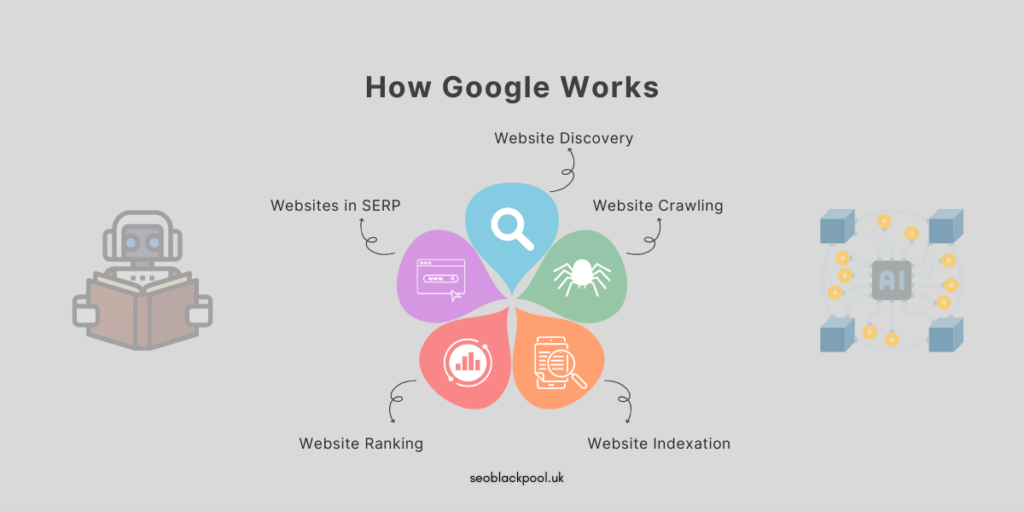
Ranking and Order Results
Google’s principal algorithm for search is called Google Hummingbird It is responsible for deciding on how to rank and order results from search engines. Google also offers a machine-learning sub-algorithm for search engines called RankBrain:
If RankBrain detects a word or phrase that it’s not familiar with, it employs artificial intelligence to make sense of it better by linking it to search queries that are similar. It helps Google to comprehend these queries by converting the keywords into concepts and topics that are well-known that means it can give better results for search results even when the questions are not common.
Instead of trying to provide the most optimized for keywords, RankBrain rewards websites that give satisfaction to users and provide what the user is looking for.
How to Get the Most Value from RankBrain
An effective SEO approach is to improve the performance of your site to increase the experience of users and their satisfaction, and to make maximum benefit from the ranking factor RankBrain.
The three most effective methods to achieve this are:
- Optimize your website for medium-tail keywords (key words that are composed of up to 3 words).
- Optimize the page’s title and description for clicks so that , when you search, your website will be more likely to be clicked. The click-through rate is the proportion of users who view your site on Google and go on and visit your site.
- Optimize your content to increase the duration of stay (the duration that people remain at the site) and decrease bounce rate (the proportion of people who leave after just seeing a page).
Remember that Google’s top 3 ranking factors include:
- Links
- Content
- RankBrain
The Structure of the Search Results
Search Engine Result Pages or SERPs comprise paid search results as well as “organic” search results, in which the organic results don’t make Google’s profits. However, Google delivers organic results in accordance with its assessment of the relevance and quality. Based upon the nature of inquiry, Google will also include various elements in the SERP, such as images, maps, or videos.
The amount of advertisements in a SERP will depend on the type of search that users have made. If you search for the term “shoes,” for example you’d probably find an overwhelming majority among the results that top being ads. In reality, you’ll need to scroll down the page to locate your first search result that is organic.
Such a query usually produces a lot of ads since there’s a high probability that the user is trying to purchase shoes online and there are a lot of shoe manufacturers willing to offer a feature on results from AdWords result for the search.
However, when you search for something that is similar to “Atlanta Falcons,” your results might differ. Because the search is connected with the pro American football team that bears this name The top results are related to the team. But it’s a less precise search. The results include news stories and a knowledge graph along with their website. These three types of results on the top of the list indicate that Google isn’t aware of the exact purpose of your search but it provides quick routes to find out more about the team, read the most recent news or visit their website.
As there is no intent to purchase to the question, the advertisers aren’t ready to compete on the keyword, therefore there are no results from Google Ads (formally “AdWords”).
However, if you alter the search query in the form of “Atlanta Falcons hat,” that signals to Google that you may be looking for something The SERP results are changed to show more ads.
How Google Earns Money
Google is able to earn money from believing in and trusting its search engine. It does this by providing relevant results for its users.
Google offers businesses the possibility of paying for an advertisement to be placed at the top of the page of results. “Ad” is the word that “Ad” indicates these listings. Google earns money when users take a look at these Pay-per-Click (PPC) advertisements that you can purchase via AdWords. These ads are displayed for more general queries particularly.
In addition to the small mark, these search results are almost identical to other results. Naturally it’s not a coincidence because a lot of people are able to click on these results, without even realizing they’re ads.
This is the kind of thing Google is based on. Advertising revenues made up more than 80 percent from the $182.5 billion Google produced in the year 2020. While search remains its primary product however, it is dependent upon its business of advertising.
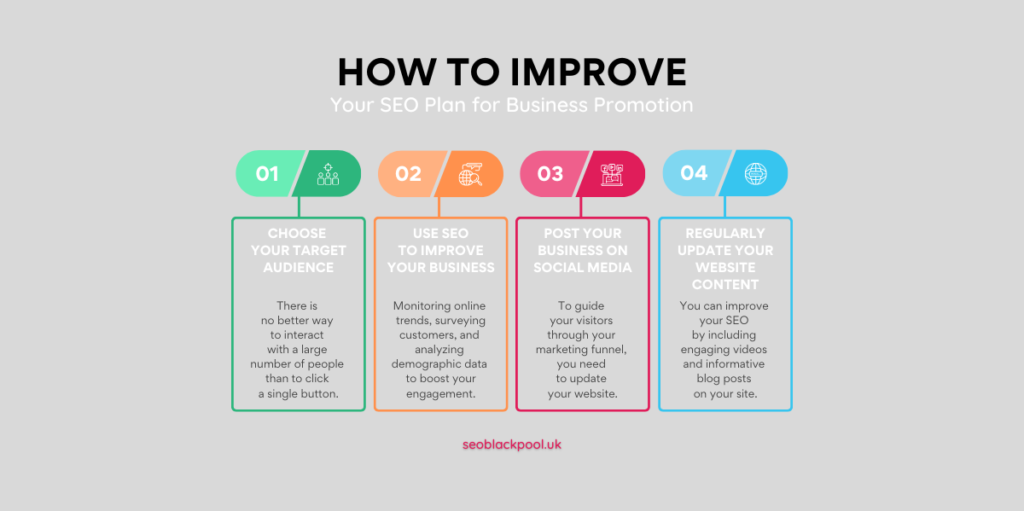
SEO Marketing Basics: The Complete Breakdown
It’s time to understand how to implement SEO marketing. It’s one thing to know however, SEO takes a lot of time and effort. It isn’t something you can alteration to today only to see results in the next day. SEO implements daily activities that are aimed at lasting success.
Content
It’s probably been said in the past: “Content is king.” Bill Gates made this prediction in 1996 and it’s just as valid as ever. The Google users can only be happy if Google they find the results that meets their requirements in the most efficient way. That is ONLY possible with great content.
If you Google “quick and easy homemade mac and cheese,” Google invests its full energy in delivering to you the recipe that Google thinks is the most effective mac and cheese (that requires only a few minutes and requires only a few ingredients) across the internet.
It doesn’t search for the fastest recipe, but the simplest recipe, or just several online stores for frozen meals. It strives to provide you with exactly what you’ve asked for. Google always strives to provide the best possible experience for you by providing you with the best content available.
Thus, your primary job in SEO is to produce high-quality content. It’s not a good thing, is it? It’s still necessary to perform a lot of effort. SEO isn’t any different from any other skill. Great results require a lot of work. Similar to how the top marketing will not aid in selling a poor product, super-advanced SEO won’t help if you do not have quality content.
Elements of Content
There are millions of elements that are involved in creating top-quality content. Here are few of my top ones:
Quality
At one time, publishing the content using keywords was the norm. If you had created high-quality content that actually addressed a issue and was unique, you were an outlier and it was very easy for you to be ranked.
Nowadays, content is better and more popular, and many businesses online have blogs which improve the value of their website and get higher rankings on Google.
Making amazing content isn’t an easy task but the good thing is that you don’t have to develop your content completely from scratch. You can build on the content that others have already created, and simply enhance the worth and make your content more thorough.
The main thing to remember is that your article needs to address a need or provide a solution for what brought readers to your page. If your content doesn’t do that, they’ll leave your site and inform Google that your content doesn’t solve anyone’s issue.
Intent
Google places a great deal of focus on intent. It wants to know what people are searching at when entering something in its search engine.
- Do they wish to learn something?
- Are they trying to purchase something?
- Are they going to the mall?
As the creator of content, you must be aware of this, too. You shouldn’t write an article about what are the “best ice fishing rods” and then use “bass fishing” as your main search term. This isn’t logical since most people don’t use rods for fishing ice for bass in the winter. So, you’re not offering an answer that is appropriate to the question and Google will find out.
Freshness
HubSpot established a benchmark that shows that frequent posting can help with Google rankings. But, publishing new content isn’t the only method to show Google newness. There are a lot of ways that you could do to content that you’ve already published to keep it current.
The process of reviewing your content and making changes to ensure accuracy, fixing broken links and refresh old data with new stats that are more relevant are methods of showing Google that your content is still worthy of a place on the first page.
Keyword Research and Selection
We’ve just touched briefly on keyword research, which determines the name of your website or the way you present your company’s image on the internet. Keywords can also determine the way you create links, from the methods you pick to the way you plan on applying them. Another mistake that people often make is stopping.
Perhaps they revamp their site or release an innovative marketing campaign. They go through one or two weeks updating their sites after which they cease. They believe that keyword research is an all-in-one thing. Actually, it’s exact opposite. SEO professionals are always conducting keyword study.
Keyword research is conducted to satisfy a variety of needs The two main motives are to be ranked on Google and produce relevant content. Keywords often provide creativity by providing you with what people are looking for according to what they are searching for.
Elements of Keyword Selection
There’s more to choosing a keyword than just using your tool for keyword research and selecting every keyword from the list. It is important to know the purpose behind the keyword and also its competition. These are the main factors that influence the selection of keywords:
Choosing the Right Keywords
Let’s suppose you sell consulting services. Your services could cost clients 10,000 in the period of one year. This is less than a thousand dollars each month, so it’s possible but it’s still quite costly.
Now, if you’re currently ranked at the top of the list for “free business growth tips,” do you know what crowd you’re likely to draw?
Your site will attract people who are seeking free products! It’s a good bet that they’ll not give their credit card as soon as they visit your website. This one keyword could drive your website thousands of visitors every month. It’s most likely not the right audience, and it’s not logical to get a position for it. It’s better to choose an alternative keyword even if that involves giving up 990 visitors per month.
Imagine if you can find just one or two readers read the article is enough, then you’re ahead. This isn’t the only frequent error I’ve seen, however. Actually, this one is even more prevalent.
Competition Analysis
You’ve picked the correct keyword right from the start. It’s relevant to the context of the work you’re doing and is more in line with what you’re trying sell. What’s the next thing you’ll do?
You launch an online tool for keyword research such as Ubersuggest to find keywords with similar terms. Naturally, you’ll gravitate towards those with the highest volume of searches however, here’s what you’re missing: Your capability to be ranked for a specific keyword is often dependent on the competition you’re playing against.
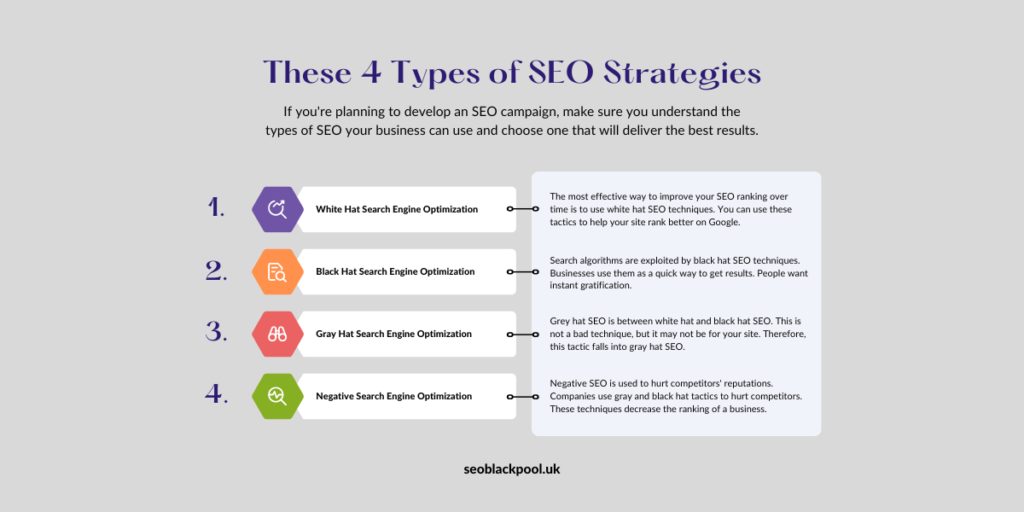
Establishing SEO goals
The setting of SEO goals is an essential component in every SEO strategy. It is essential to set SEO goals – and be sure that they are in line with the overall goals of your business – due to:
- They are able to encourage the buy-in of principal players.
- They can help you formulate an SEO strategy.
- They make sure that they meet their goals.
What Should You Be Measuring?
Although it may seem like it’s a daunting task to set goals, measuring them will assist you in making improvements to your SEO over the long run. What kinds of things are you supposed to measure?
- Take into consideration how to measure:
- Keywords
- Traffic
- Market share
- Brand recognition
- Lead generation
- Reputation
- E-commerce
Setting SEO Goals for Various Types of Companies
The goal of your business will differ based on the nature of your business, informational or transactional. If your company is transactional, and you’ve got an e-commerce component you’ll need to define your goals in tracking leads and sales conversions. But, if you’re a commercial website that isn’t ecommerce then you should focus on lead generation.
If your company is informational then you’re more likely to set goals that focus on brand recognition or traffic to your website.
Keep in mind that even after having successfully implemented an SEO plan, SEO is never finished. When it comes to SEO it’s possible to alter your strategy midway through or play a lengthy game, and then wait for the final outcomes. However, with an established SEO base in place with a bit of patience, the advantages from your SEO strategy will become evident which will result in an improved user experience for customers, and greater revenue for your company.
SEO Strategies: Black Hat Vs. White Hat
It has always been a long-term game of entrepreneurship and believe that it’s the right way to take. But, that’s not the situation for all. Certain people prefer the benefits quickly and then move on to another thing.
In the case of SEO, the pursuit of quick gains is commonly described as “black hat SEO.” Users who employ SEO that is black hat tend to employ tricks such as keyword stuffing and link scraping to get their site ranking quickly. It may work for the short term and bring some visitors to your website but, after a few months, Google ends up penalizing and blacklisting your website which means you won’t get a ranking.
However white hat SEO is the most effective way to create a sustainable online business. If you approach SEO this way, you’ll be focusing on your audience’s needs. It is your goal to offer them the most relevant content you can and make it accessible through playing by the rules of the search engine.
Duplicate content: When a website attempts to rank on Google for a specific phrase, they may copy pages on their site in order to include the keyword to appear in their content repeatedly. Google punishes websites for doing this. Keyword stuffing and invisible text A long time ago the black hat way of doing things was to put a large number of keywords in the footer of your posts, but making them the same color as your background. This tactic will result in you being immediately blacklisted. This is the same for adding keywords to places they aren’t needed.
The process of redirecting and closing: when redirects are involved, there’s a correct and incorrect method of doing it. The wrong approach is to buy several keywords-rich domains and redirecting all traffic to a single website. Poor link building practices: Going to the mall and buying a Fiverr deal that promises you 5,000 links within 24 hours isn’t the correct way to construct links. It is important to obtain links from relevant content as well as sites which have an own source of traffic.
Since Google punishes websites that do these kinds of things, you’ll see me talking about SEO done in white hats. There’s such a thing called gray hat SEO but it’s not as effective. It’s not as innocent or pure like the whitest hats, however it’s not nearly as manipulative as black-hat methods could be. You’re not trying to deceive anyone or try to manipulate the system by using gray hat. But, you’re seeking to obtain a clear advantage.
The Google standards aren’t as precise as they’d like you believe. Sometimes, they may even make statements that contradict each other. For instance, Google has said they’re not an advocate of guest blogging in order to create links. Then, how do you think about guest blogging to increase your business? What if you did it to raise brand awareness, drive high-quality return traffic to your site and establish yourself as known as a household name within the field?
Conclusion
In the world of SEO It’s not all the things you’re doing, but the way you go about it. If you’re paying for guest posts from sites which have nothing to do with your industry and are spamming many hyperlinks, you’ll be disqualified. If you’re making original guest posts that offer the readers with value on websites that are relevant to your business and your business, you’ll be fine and the links will flow smoothly to your website.

